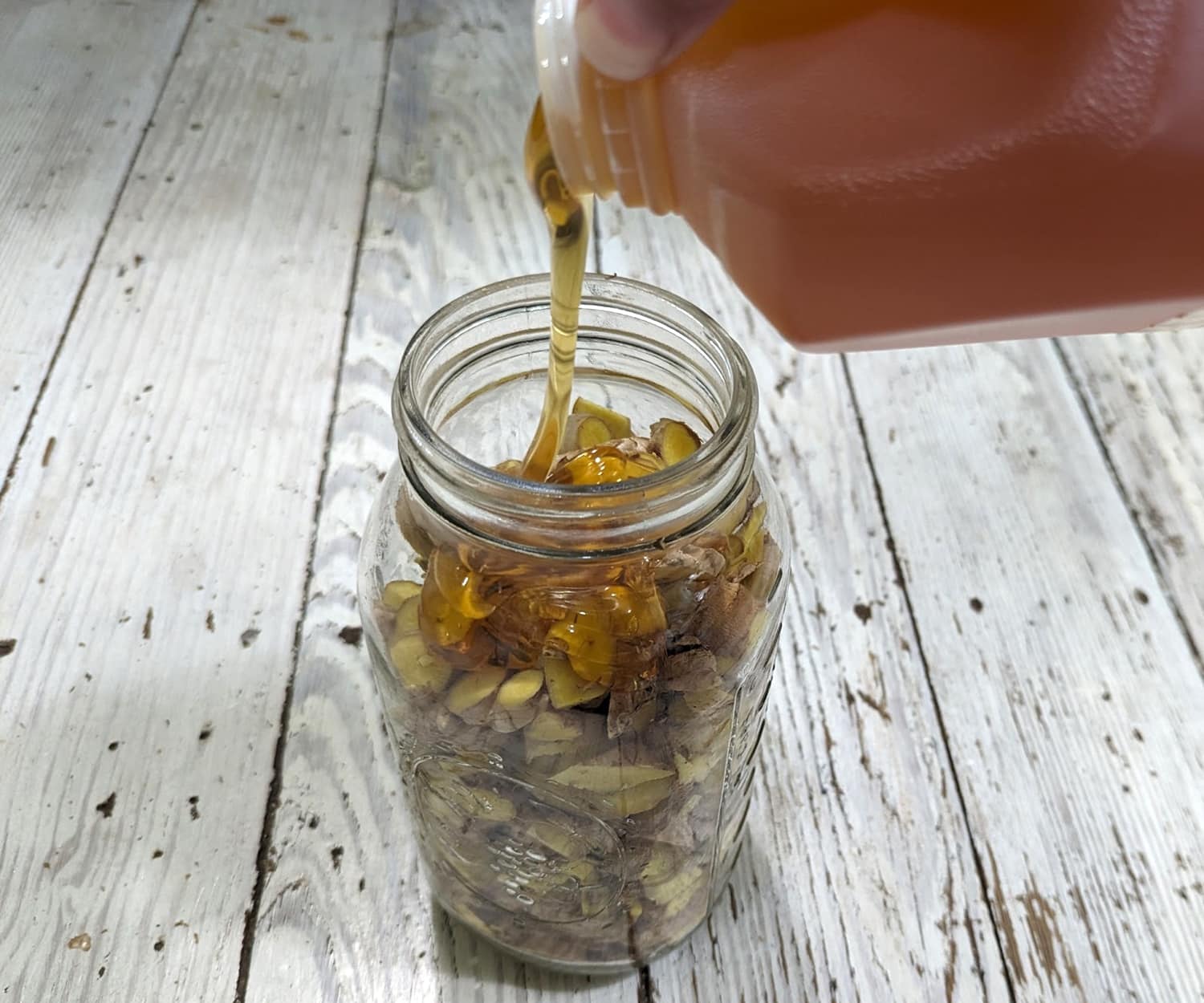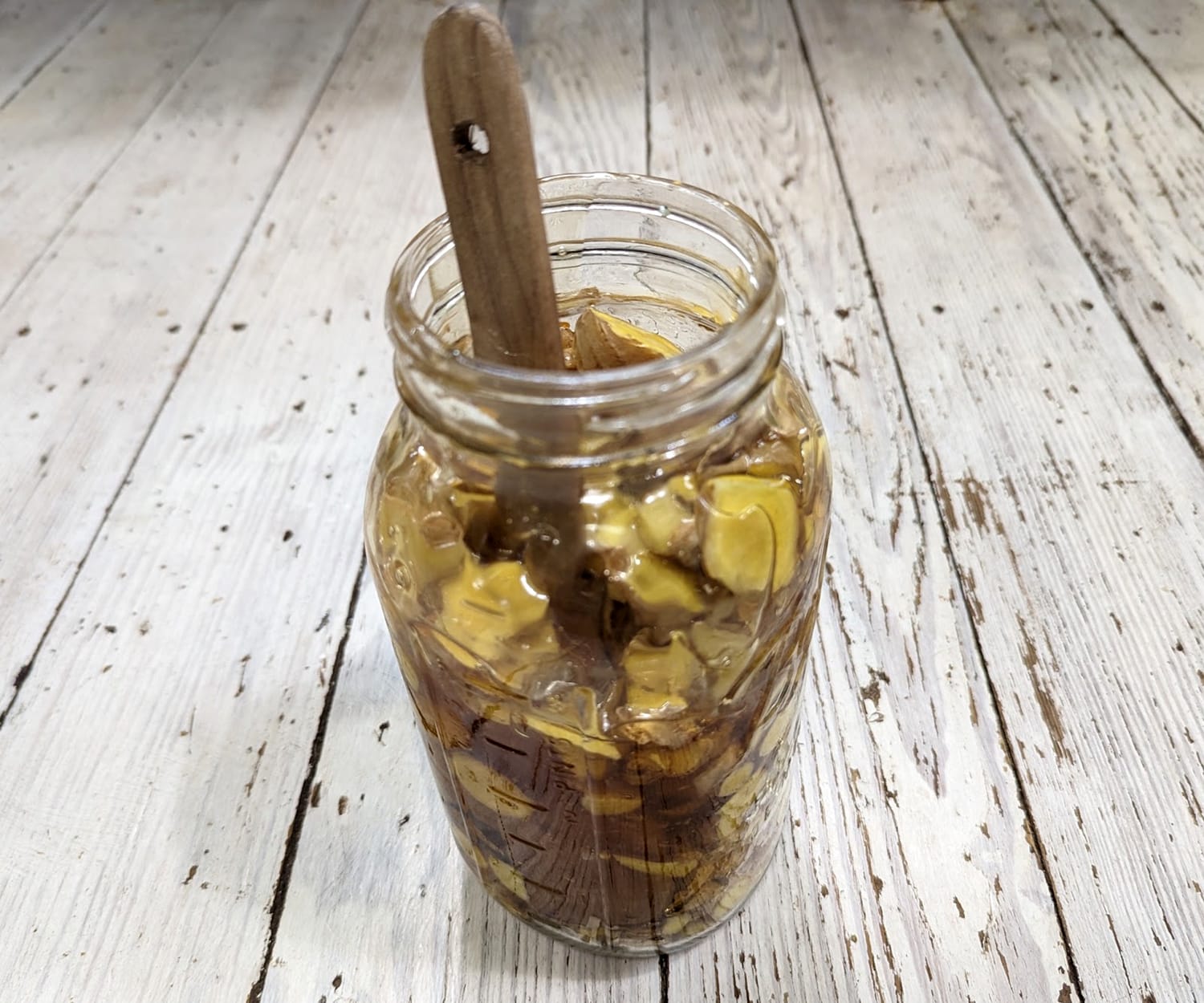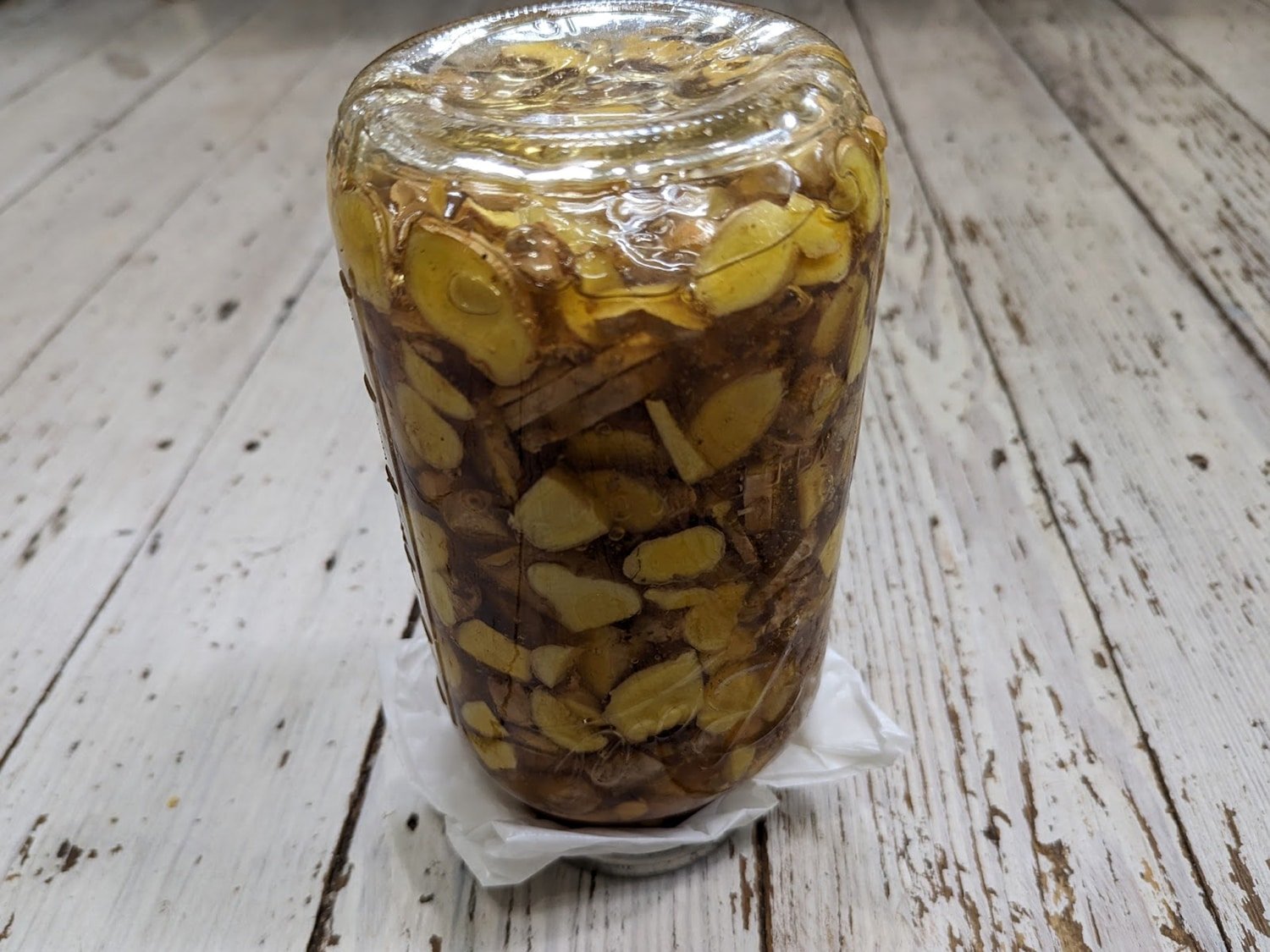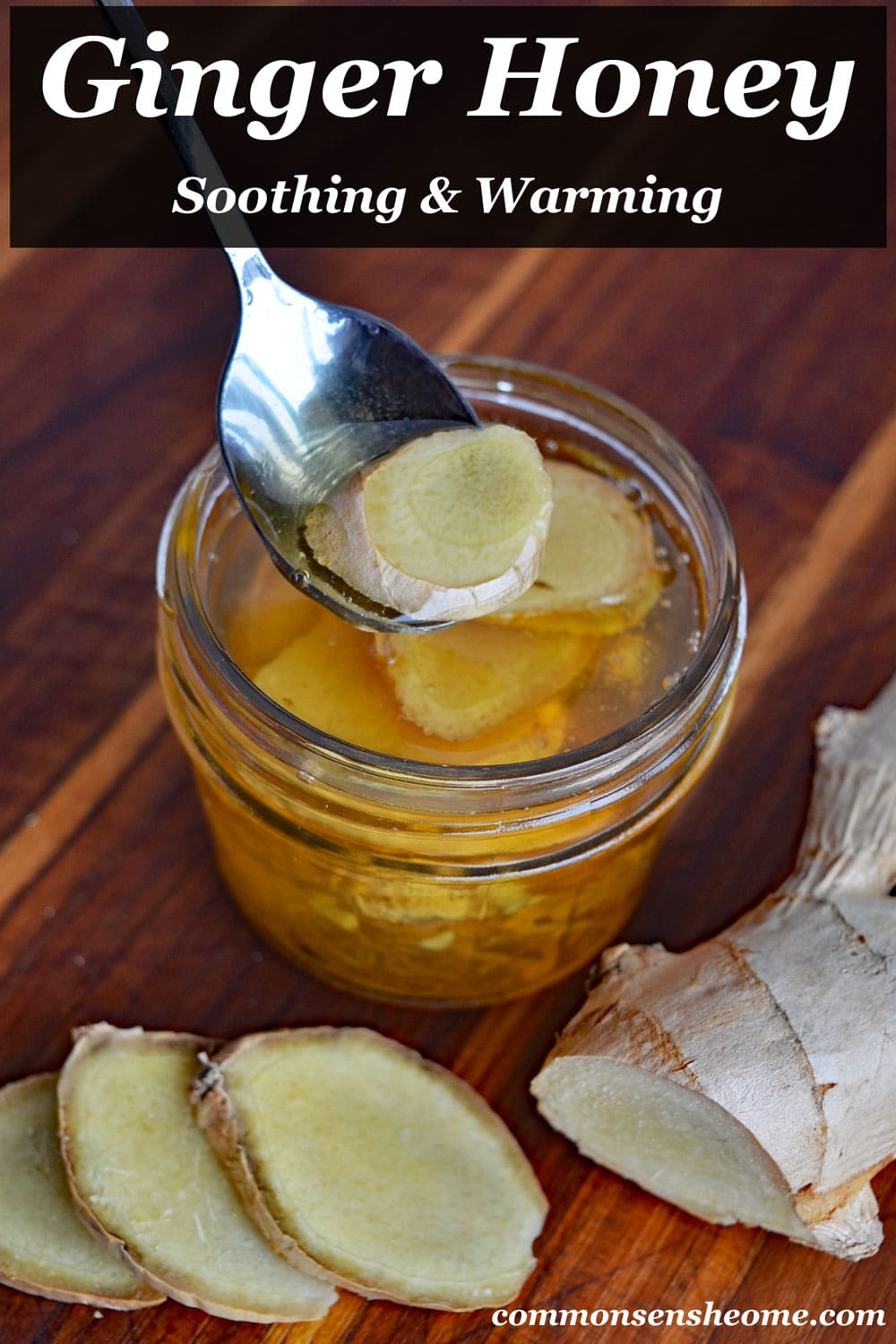Soothing & Warming Ginger Honey (Honey Fermented Ginger)
This post may contain affiliate links. Read my full disclosure here.
Ginger honey, or honey fermented ginger, is good food and good medicine. It’s the perfect remedy to have on hand for cold and flu season. The anti-inflammatory and warming properties of ginger make it perfect for soothing coughs and sore throats.
See “Ginger Root Uses & Health Benefits” for more ginger goodness. This recipe uses Ginger root (Zingiber officinale), not wild ginger root (Asarum canadense), which is a different plant.

The juice from the ginger combines with sugars in the honey and begins a fermentation process. The fermentation process breaks down the nutrients in the ginger, which makes them easier for our bodies to digest and assimilate.
It also adds beneficial bacteria and yeasts that, among other things, produce a significant quantity of vitamin K2. We often hear of needing to get sunlight, or take vitamin D3 but what we don’t hear enough of is that our body needs K2 because D3 and K2 work together; D3 needs K2.
You can use it the same way you would honey. Stir it into tea or a hot toddy, drizzle it over ice cream. It adds a nice kick to your stir fries, salad dressings, or even just on a buttered piece of toast. I like to spoon out pieces of ginger and eat them just like that.
Making Ginger Honey
To make honeyed ginger, all you need is fresh ginger, a sharp knife, a spatula or butter knife, a cutting board, and raw honey. It is important that you use raw honey, as the natural yeast and bacteria are necessary for fermentation to occur.
You do not need to peel the ginger, just wash it and let it dry a bit. You don’t want water in your honey, because it could cause spoilage. Organic ginger is best, if available.

Next, fill your jar with the ginger, leaving some room just below the rim line. Add your honey a little at a time.

Slide the spatula alongside the jar so the honey can settle all the way to the bottom of the jar.

Would you like to save this?
Once the jar is filled with the honey to the rim, either put a lid on your jar, or a band, with wax paper, and add a label. Place your honey on a plate while it is actively fermenting, as some of the honey may ooze out and down the sides as it bubbles.
Tighten the lid and then flip your jar on end so that the honey can work its way through the ginger.

Invert the jar a couple of times per week to make sure the ginger stays coated.
When not inverted, loosen the lid a bit to allow it to breathe, and let it set. In a couple days you will notice bubbles forming on the top, which means it’s working!
You can eat the ginger, or the honey, at any point, but the flavor develops as it sits. The ginger may not be as spicy, and the honey will become dark and runny. Don’t leave your honey at room temperature for over a month, or it will turn to an alcoholic ferment.
Storage
After two weeks, store your ginger honey in the refrigerator to slow the fermentation. Your honey will keep for a year or more.
Honey fermented ginger is so delicious and helpful as a home remedy that you may want to make a large batch. You can repack it into smaller jars for sharing or gift giving.
Optional Add Ins
Add raw garlic, raw onions, and raw cranberries to make your honey more interesting and contribute more medicinal properties. Use garlic cloves and cranberries whole, or crush them to release more juices. Eat pieces straight out of the jar, or use the honey spread on toast or even slices of your favorite cheese.


This article was written by Sylvia Gunther. Sylvia studied under Rosemary Gladstar and earned the distinction of Traditional Herbalist. She then studied Clinical Herbalism through The Herbal Academy, where she continues her life long exploration of herbs.
Sylvia and her husband live in North Central Indiana. Together they raised six beautiful children.


I was just thinking of mixing ginger and honey as ginger is quite cheap just now. I had thought if blitzing the ginger before packing it into a few jars of honey. I found the thin slices of ginger my son added to a stir fry too tough.
Chopping finely or blending is fine. I would probably fill the jar only half full with very finely chopped ginger, to make sure you have enough honey to balance it out.
Can you use ginger that has been frozen?
Sure, that’s fine.
This sounds so good and easy! Something the grands would actually take! I am thinking about adding some dried elderberries and a couple cinnamon sticks…
Sure – those both go well with ginger and add a little extra immune boosting punch. There’s so much garbage in most of the commercial cough syrups.
I have been tending to my ferment daily, but have been keeping it in my cupboard for about 2 months now. it smells a little alcoholic. is it still good?
If there’s no fur (mold) or other signs of spoilage, it’s likely safe to consume, though you may be on your way to ginger hooch. Typically, I keep it at room temp no longer than a month before refrigerating. I will update the article to attempt make this clearer.
Can I ferment in larger jar, then divvy into smaller to smaller gift jars for Christmas? Thinking the ginger and cranberry would be beautiful. Also, if I pour into smaller jars, do I add some of the ginger and cranberries to those jars? Thank you.
Sure, fermenting in a larger jar and dividing is fine. I would add some of the ginger and cranberry into each smaller jar. It would make a more striking presentation, and then it’s easier for the recipients to tell what they are receiving.
I followed these instructions but due to some unusual circumstances, my honey has sat since October 31st. Yesterday I noted a bit of foaming on the top and a bit of a fermented smell when I opened it. Does this mean that my honey has gone bad, or just gotten a real good fermentation on it? Additionally, can you give me any idea of what the Ph should be by this time, and if it is above a ph of 6 do I have a problem with botulism? Thanks for the reply. Don
The pH of honey is between 3.2 and 4.5. The pH level of raw Ginger ranges from 5.60-to 5.90.
From what you describe, it’s fermenting, which is normal, and why it’s called honey fermented ginger. If your pH is 4.6 or lower botulism spores cannot grow.
Botulism requires free water. Honey is hygroscopic – it binds water. You’re also supposed to have been flipping the jar to keep the ginger coated and opening the lid slightly to let the ginger honey breath. Flipping keeps the ginger submerged to avoid mold, and keeping the lid slightly loose lets CO2 out as it ferments.